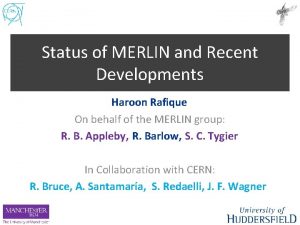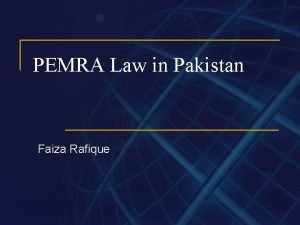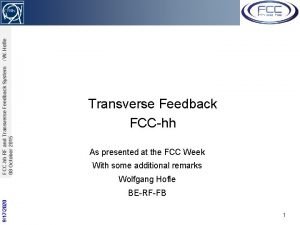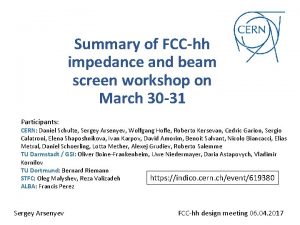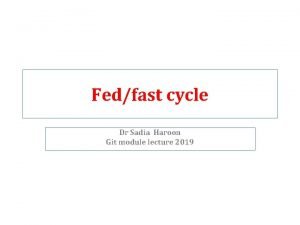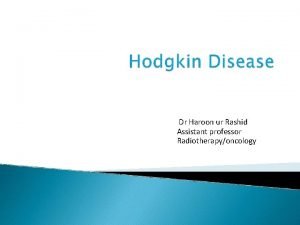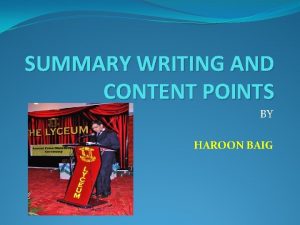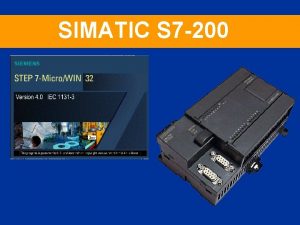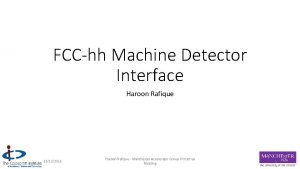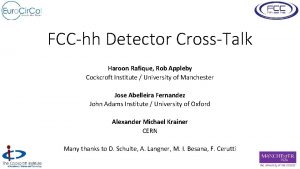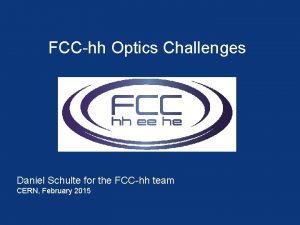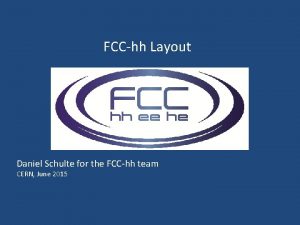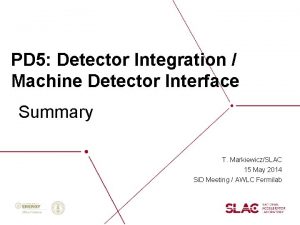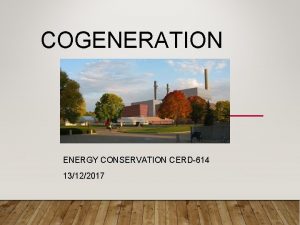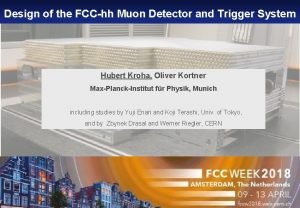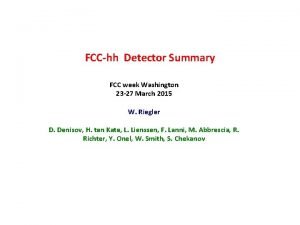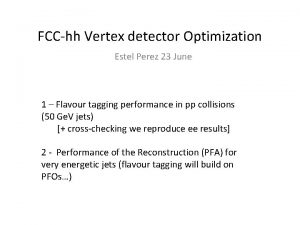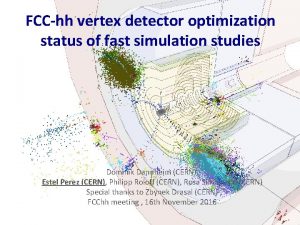FCChh Machine Detector Interface Haroon Rafique 13122017 Haroon

![LHC 26. 67 [km] 1. 1 ∙ 1011 2808 1 ∙ 1034 8. 3 LHC 26. 67 [km] 1. 1 ∙ 1011 2808 1 ∙ 1034 8. 3](https://slidetodoc.com/presentation_image_h2/153d05173d639e1ee727888b2fb611d5/image-2.jpg)


![Pions Muons Protons Photons Collision Products (3 [m] post IPA) Crossing Mean protons per Pions Muons Protons Photons Collision Products (3 [m] post IPA) Crossing Mean protons per](https://slidetodoc.com/presentation_image_h2/153d05173d639e1ee727888b2fb611d5/image-5.jpg)









- Slides: 14

FCC-hh Machine Detector Interface Haroon Rafique 13/12/2017 Haroon Rafique - Manchester Accelerator Group Christmas Meeting 1
![LHC 26 67 km 1 1 1011 2808 1 1034 8 3 LHC 26. 67 [km] 1. 1 ∙ 1011 2808 1 ∙ 1034 8. 3](https://slidetodoc.com/presentation_image_h2/153d05173d639e1ee727888b2fb611d5/image-2.jpg)
LHC 26. 67 [km] 1. 1 ∙ 1011 2808 1 ∙ 1034 8. 3 [T] 350 [MJ] 7 [Te. V] 13/12/2017 26. 67 [km] 3. 5 ∙ 1011 1404 7. 55 ∙ 1034 11 [T] 675 [MJ] 7 [Te. V] ~100 (97. 7) [km] 1 ∙ 1011 10000 - 50000 5 - 30 ∙ 1034 16 [T] 8400 [MJ] 50 [Te. V] Haroon Rafique - Manchester Accelerator Group Christmas Meeting 2

(Some of the) Challenges • • • Civil engineering (major cost) 16 Tesla dipoles (~4500 of them) Cooling – Liquid He Beam injection – LHC? 30 [W/m] synchrotron radiation 50 [Te. V] (100 [Te. V] Co. M) proton – proton collisions! Detectors Collision debris Extraction magnets - ~100 kickers (LHC has 15) Beam dump – how long? (LHC has a 7 m carbon dump) 13/12/2017 Haroon Rafique - Manchester Accelerator Group Christmas Meeting 3

Cross-talk • The FCC-hh Experimental Interaction Region (EIR) is critical in defining FCC-hh performance • Experimental cross talk is a possible issue due to high luminosity and energy proton beams • We use IPA to IPB as a representative case Questions: • Do protons from collisions reach the next detector? • What effect will this have on operation (background, emittance, losses, etc)? • Do other collision products reach the next detector? • Are there any areas of concern? – if so how do we address them. 13/12/2017 Haroon Rafique - Manchester Accelerator Group Christmas Meeting 4
![Pions Muons Protons Photons Collision Products 3 m post IPA Crossing Mean protons per Pions Muons Protons Photons Collision Products (3 [m] post IPA) Crossing Mean protons per](https://slidetodoc.com/presentation_image_h2/153d05173d639e1ee727888b2fb611d5/image-5.jpg)
Pions Muons Protons Photons Collision Products (3 [m] post IPA) Crossing Mean protons per primary 1. 43 Mean energy of protons 13418 Ge. V Mean mu- per primary 0. 142 Mean energy of mu- 10. 7 Ge. V Mean charged hadron per primary 23. 4 Mean energy of CH 396 Ge. V Mean gammas per primary 19. 3 Mean energy of gammas 238. 9 Ge. V Charged hadrons other than protons ignored (for cross-talk) due to rigidity. Elastic: E > 49. 95 Te. V Inelastic: E < 49. 95 Te. V Generated using DPMJET-III inside FLUKA Split protons into 2 cases: Elastic and inelastic 13/12/2017 Haroon Rafique - Manchester Accelerator Group Christmas Meeting 5

Elastic Protons Tracking performed with PTC and MERLIN Elastic protons all reach IPB with no losses. This will lead to emittance growth. Not a major concern, so we concentrate on inelastic protons No Crossing IPA IPB 13/12/2017 Haroon Rafique - Manchester Accelerator Group Christmas Meeting 6

Power deposited with and without TCLDs ~8 k. W in 200 m drift 13/12/2017 ~1 k. W in 45 m drift 790 W in TCLD 8 Haroon Rafique - Manchester Accelerator Group Christmas Meeting 224 W in TCLD 10 7

Muons can travel far in dense materials. Theoretical calculations estimate a range of ~ 3 km. Theoretical range of muons in standard rock scored at s = 10 m post IPA Muon E at a given s post IPA 13/12/2017 Haroon Rafique - Manchester Accelerator Group Christmas Meeting S [m] 8

Muon tracking in FLUKA J. L. Abelleira (JAI, Oxford) Theoretical estimate of range has been confirmed using FLUKA simulations. Muons should not reach the next IP. 109 muon histories scored at given s in FLUKA Muons generated using DPMJET-III inside FLUKA, with a full detector model, by M. I. Besana Cross-Talk Studies between FCC-hh Experimental Interaction Regions, IPAC 17’, TUPVA 036 J. L. Abelleira, A. Seryi, M. I. Besana, R. Appleby, H. Rafique 13/12/2017 Haroon Rafique - Manchester Accelerator Group Christmas Meeting 9

Cross-talk summary (including previous work) • • 50 Te. V proton collisions modelled using DPMJET-III in FLUKA Proton tracking performed with PTC and MERLIN Elastic protons all reach the next IP with spot size ≈ beam Inelastic proton cross-talk not of great concern • 1 – 10 protons per IPA bunch crossing at IPB FCC-hh v 7 • Slightly reduced for FCC-hh v 8 • DS losses mitigated when using existing TCLD design & settings – IPAC TUPIK 037 • Muon tracking performed with FLUKA • Muons do not have the range to get to the next IP – IPAC TUPVA 036 • No major incidents due to new lattice from cross-talk perspective 13/12/2017 Haroon Rafique - Manchester Accelerator Group Christmas Meeting 10

Machine Induced Background • Major contributors: beam-gas interaction, halo and collision debris losses. • Started a study using FLUKA • Gas density profile required from vacuum team (ongoing) 13/12/2017 Haroon Rafique - Manchester Accelerator Group Christmas Meeting 11

13/12/2017 Haroon Rafique - Manchester Accelerator Group Christmas Meeting 12

13/12/2017 Haroon Rafique - Manchester Accelerator Group Christmas Meeting 13

13/12/2017 Haroon Rafique - Manchester Accelerator Group Christmas Meeting 14
 Haroon rafique
Haroon rafique Pemra cable tv licence fee
Pemra cable tv licence fee Conclusion of victorian literature
Conclusion of victorian literature Fcchh
Fcchh Fcchh
Fcchh Salaina
Salaina Fedfash
Fedfash Dr haroon ur rashid
Dr haroon ur rashid How to write content points
How to write content points Abowd and beale framework example
Abowd and beale framework example Office interface vs industrial interface
Office interface vs industrial interface An interface
An interface Interface in interface java
Interface in interface java Human machine interface
Human machine interface Moore machine and mealy machine
Moore machine and mealy machine
